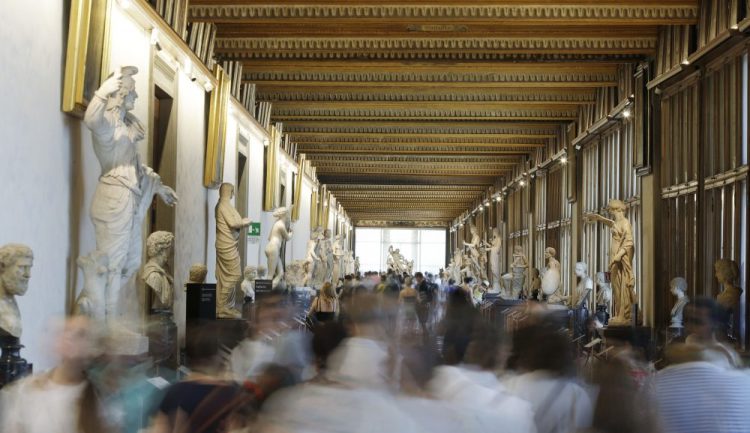ROME — The director of Italy’s Uffizi Galleries is predicting a boom in visitors after coronavirus restrictions end, judging by what happened after previous emergencies closed down one of the world’s most popular museums.
Museum director Eike Schmidt recalled that after the Arno River flooded Florence in 1966 and shuttered the museum, the number of visitors to the Uffizi jumped from 1 million to 1.5 million in 1968. He said the Uffizi saw a similar attendance growth spurt after the Italian Mafia in 1993 set off a car bomb behind the museum, killing six people, damaging artworks and forcing the museum’s temporary closure.
When Italy’s 6-week-old lockdown eventually ends and the Uffizi reopens, Schmidt expects the initial wave of visitors to be Florentines and other Italians.
“Internal tourism will dominate in the mid-term,” Schmidt, a German who is the Galleries’ first non-Italian director, said. “Over the long term, I don’t see a drop in interest in visiting museums,” he said, speaking by video hookup with Rome-based foreign journalists on Monday.
A form of social distancing the Uffizi implemented two years ago — not to guard against viral contagion but to discourage crowds from bunching up in front of popular masterpieces – is likely to help, he said. The museum introduced timed entrances, revised ticket prices to encourage off-season buying and revamped the placement in gallery rooms of paintings like Botticelli’s “Birth of Venus.”
Italy was completing its sixth week under a nationwide lockdown Monday and has at least two more weeks to go as part of government efforts to slow the spread of the coronavirus.
The lockdown came as the museum’s high season was beginning, although Schmidt noted that in recent years the Uffizi’s greatest growth in ticket sales has been in the off-season, when art-rich Florence is less crowded.
He estimated that the galleries lost 10 million euros ($11 million) in revenue being closed in March and April. In 2019, the Uffizi Galleries, which include Pitti Palace and the Boboli Gardens, drew 4.5 million visitors.
The Uffizi “has broad shoulders to resist for a couple of months of closure,” Schmidt said. “What’s important is that human lives are saved.”
Forty of the Uffizi’s Raphael paintings and drawings were loaned for a blockbuster show in Rome about the Renaissance master that opened on March 5 and had to close three days later.
Black cloths now cover the paintings in the meantime — not as a sign of mourning, but to protect the works from excess light. Since the 500th anniversary of Raphael’s death is being marked during all of 2020, the Uffizi is willing to keep its pieces in the exhibit for many more months if the show is extended past the original June 2 closing date.
The Uffizi, like many other museums, is increasingly using social media to show off its collection and to maintain the public’s passion for art treasures that can’t be seen in person during the pandemic that hit Italy notably hard.
The museum established a Facebook page – admittedly, years after other institutions -after Italy’s national lockdown began. In five weeks, it had 50,000 followers, Schmidt said,
The Boboli Gardens, a perennial favorite with tourists in Florence, is part of the Uffizi complex. Last week, the Galleries tweeted photos of the trees in spring bloom.
Comments are not available on this story.
Send questions/comments to the editors.


